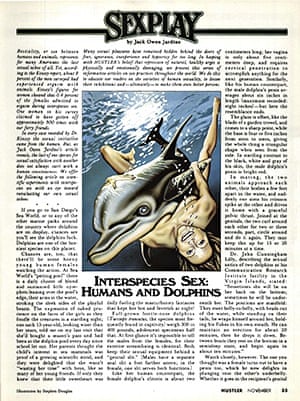Posted: Sep 18, 2018 6:49 am
This is a couple of years old but I only came across it last week. I post it here because it's intriguing and sad.
Read all; https://www.theguardian.com/environment ... o-loved-me

The dolphin who loved me: the Nasa-funded project that went wrong
In the 1960s, Margaret Lovatt was part of a Nasa-funded project to communicate with dolphins. Soon she was living with ‘Peter’ 24 hours a day in a converted house. Christopher Riley reports on an experiment that went tragically wrong
Like most children, Margaret Howe Lovatt grew up with stories of talking animals. "There was this book that my mother gave to me called Miss Kelly," she remembers with a twinkle in her eye. "It was a story about a cat who could talk and understand humans and it just stuck with me that maybe there is this possibility."
Unlike most children, Lovatt didn't leave these tales of talking animals behind her as she grew up. In her early 20s, living on the Caribbean island of St Thomas, they took on a new significance. During Christmas 1963, her brother-in-law mentioned a secret laboratory at the eastern end of the island where they were working with dolphins. She decided to pay the lab a visit early the following year. "I was curious," Lovatt recalls. "I drove out there, down a muddy hill, and at the bottom was a cliff with a big white building."
...
Lilly had been interested in connecting with cetaceans since coming face to face with a beached pilot whale on the coast near his home in Massachusetts in 1949. The young medic couldn't quite believe the size of the animal's brain – and began to imagine just how intelligent the creature must have been, explains Graham Burnett, professor of the history of science at Princeton and author of The Sounding of the Whale. "You are talking about a time in science when everybody's thinking about a correlation between brain size and what the brain can do. And in this period, researchers were like: 'Whoa… big brain huh… cool!'"
...
Man and Dolphin extrapolated Mary Lilly's initial observations of dolphins mimicking human voices, right through to teaching them to speak English and on ultimately to a Cetacean Chair at the United Nations, where all marine mammals would have an enlightening input into world affairs, widening our perspectives on everything from science to history, economics and current affairs.
Lilly's theory had special significance for another group of scientists – astronomers. "I'd read his book and was very impressed," says Frank Drake, who had just completed the first experiment to detect signals from extraterrestrial civilisations using a radio telescope at Green Bank in West Virginia. "It was a very exciting book because it had these new ideas about creatures as intelligent and sophisticated as us and yet living in a far different milieu." He immediately saw parallels with Lilly's work, "because we [both] wanted to understand as much as we could about the challenges of communicating with other intelligent species." This interest helped Lilly win financial backing from Nasa and other government agencies, and Lilly opened his new lab in the Caribbean in 1963, with the aim of nurturing closer relationships between man and dolphin.
...
Lovatt reasoned that if she could live with a dolphin around the clock, nurturing its interest in making human-like sounds, like a mother teaching a child to speak, they'd have more success. "Maybe it was because I was living so close to the lab. It just seemed so simple. Why let the water get in the way?" she says. "So I said to John Lilly: 'I want to plaster everything and fill this place with water. I want to live here.'"
The radical nature of Lovatt's idea appealed to Lilly and he went for it. She began completely waterproofing the upper floors of the lab, so that she could actually flood the indoor rooms and an outdoor balcony with a couple of feet of water. This would allow a dolphin to live comfortably in the building with her for three months.
Lovatt selected the young male dolphin called Peter for her live-in experiment. "I chose to work with Peter because he had not had any human-like sound training and the other two had," she explains. Lovatt would attempt to live in isolation with him six days a week, sleeping on a makeshift bed on the elevator platform in the middle of the room and doing her paperwork on a desk suspended from the ceiling and hanging over the water. On the seventh day Peter would return to the sea pool downstairs to spend time with the two female dolphins at the lab – Pamela and Sissy.
Read all; https://www.theguardian.com/environment ... o-loved-me
